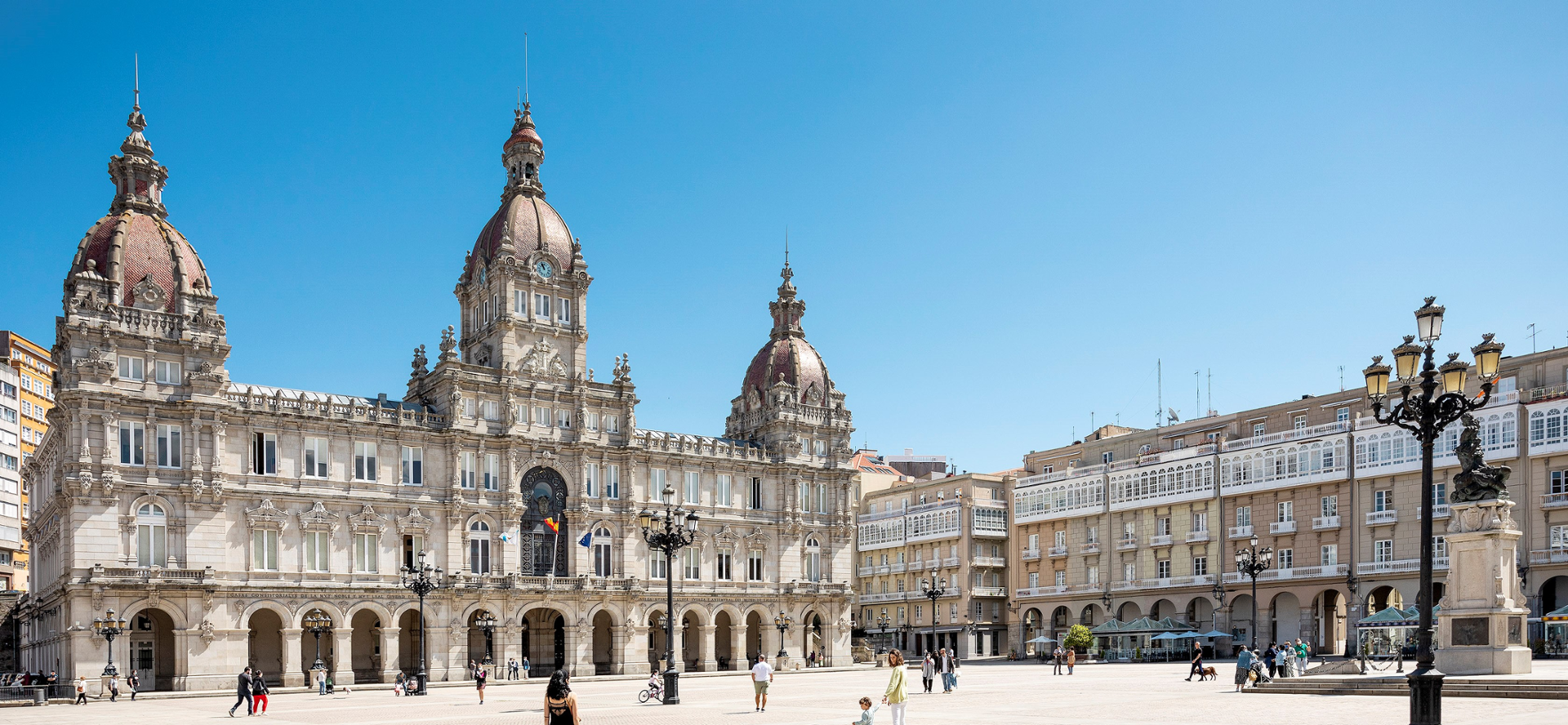- Home
- Place
Plaza de María Pita
This central square in the city of A Coruña is dedicated to the heroine María Pita. It was designed in the mid-19th century and is the location of the City Hall. The Plaza de María Pita forms a large rectangle measuring more than 10,000 square metres. On one side is the City Hall, while the other three sides are lined with arcaded buildings whose arches house various cafés and restaurants underneath.

Address:
The City Hall is a modernist building built between 1908 and 1912, occupying the northern front of the Plaza de María Pita. It was inaugurated by King Alfonso XIII in 1927. The building houses various administrative offices of the City Council.
The initial project for this building made of Galician ashlar was led by Pedro Mariño. It has a floor area of 2,300 square metres consisting of 3 storeys and an attic. Its façade was built along a front measuring 64 metres. It has 43 windows open to the exterior, and its interior has 15 arcades that rest on wide pillars.
On the first floor is the bel étage, which has several lounges - the Red, the Blue and the Golden, the latter with reliefs on the front of the seats which relate the most important historical events of the city. Also on the first floor is the Clock Museum and the Gallery of the Mayors, a corridor where each of the mayors of the city has a portrait, each one by a different artist and with a different style, with many posed wearing suits, some in tails and others, like Liaño Flores, in his lawyer's robes.
Worth a visit are the Mayor's Office and, on the same floor, the Council Chamber, with magnificent paintings by Galician artists. It is also worth mentioning the staircase of honour that connects the Mayor's Office with the Legislative Chamber, which was inaugurated in 1955 by dictator Francisco Franco and his wife, Carmen Polo.
The first floor houses offices, and the attic is where the caretaker's quarters used to be located.
On the façade, there are four carved white stone statues representing the four Galician provinces of A Coruña, Lugo, Ourense and Pontevedra. At the top, the city's coat of arms can be seen flanked by two matrons, which for some signify Peace and Industry and for others Work and Wisdom, as well as a legend with the following inscription: "very noble and very loyal city of La Coruña, head, guard and key, strength and antemural of the Kingdom of Galicia".
The highest tower houses the clock, with its bells made of an alloy of bronze and tin; they weigh more than 1,600 kilos.
The exact measurements of the Plaza de María Pita are 112 m by 99.50 m. The 112 m are those that run parallel to the City Hall; the 99.50 m corresponding to the sides running perpendicular to it.
Terraces
The terraces were designed by the Urban Design Office, a project led by the municipal architect Antonio Desmonts.
The decorative glass was carved by the Dutch company Van Tetterode.
Statue of María Pita
The statue of María Pita is the work of Xosé Castiñeiras and is made in bronze.
It stands 9.31 m high, with the pedestal accounting for 5.56 m; the sculpture itself, 3.3 m; and the platform, 0.45 m. It weighs 30 tonnes.
At the foot of the statue, there is a censer which is only extinguished from 03.00 until 07.00.
Picasso and the Plaza de María Pita
When Picasso lived in Coruña, the Plaza de María Pita already bore the same name, but there were only twelve houses located here. The statue of the heroine, installed in 1998, is based on a design by a professor at the Provincial School of Fine Arts, González Jiménez, who was an enemy of Picasso's father.




